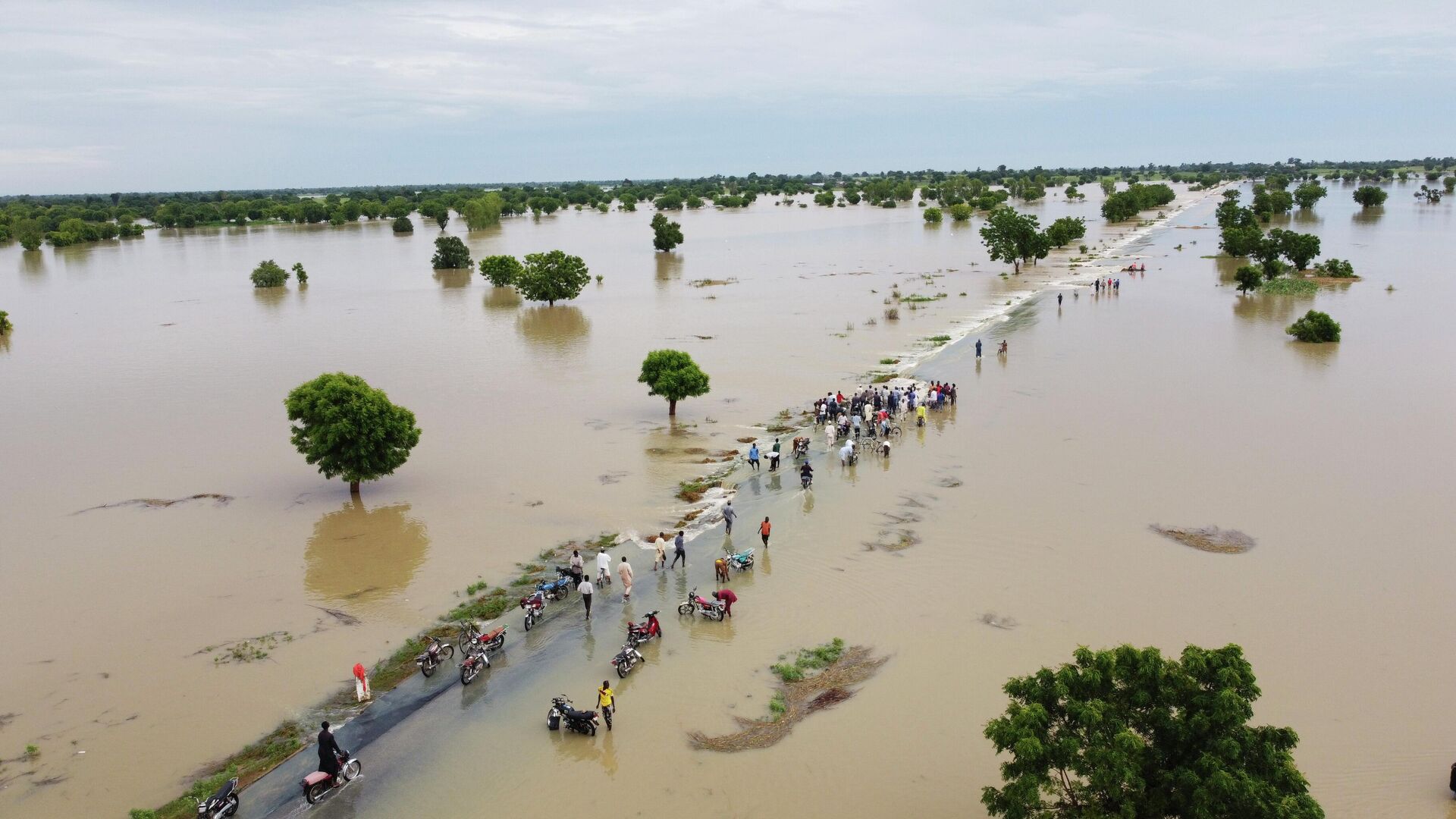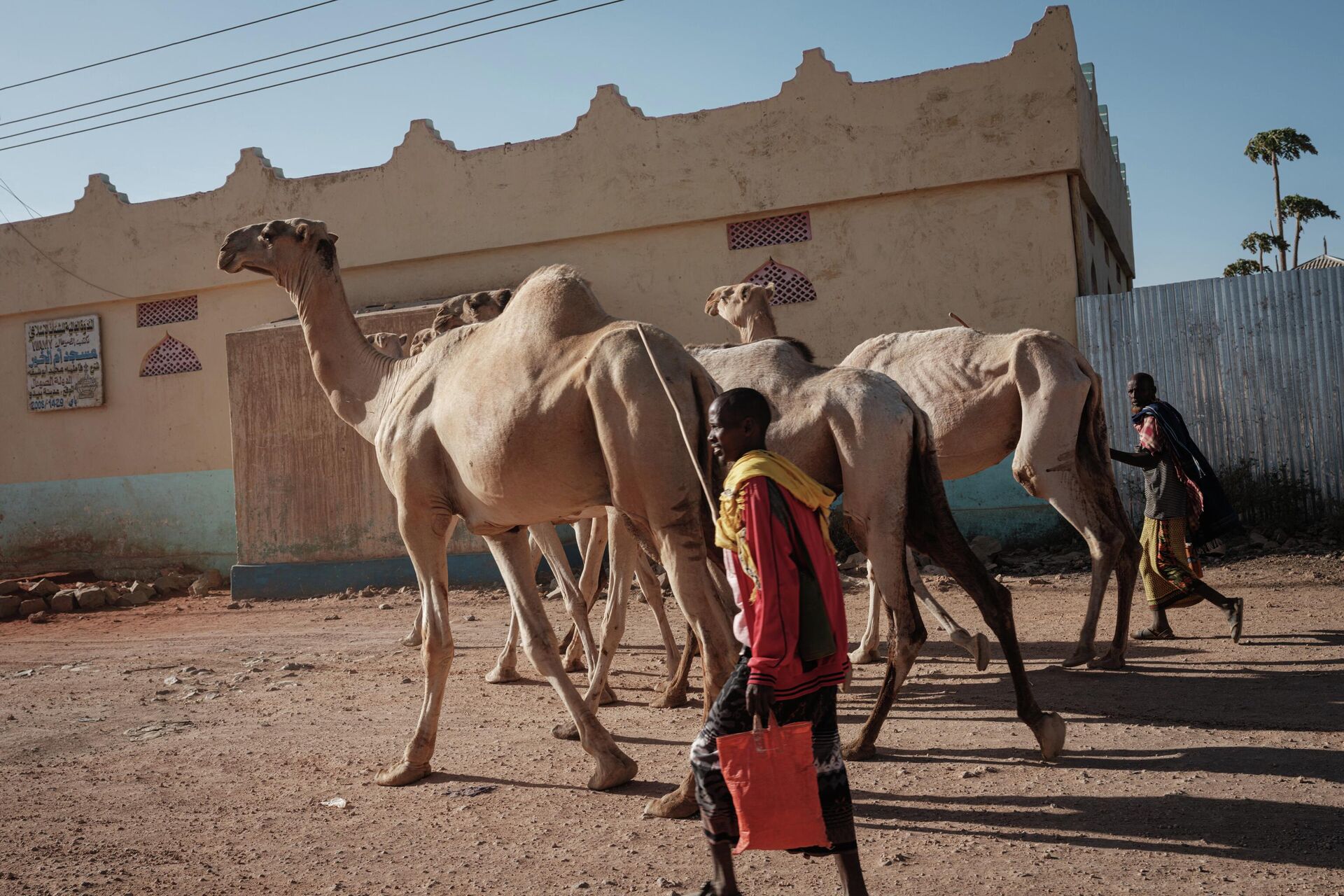https://sputnikglobe.com/20220920/photos-africas-sahel-faces-devastating-floods-as-rains-swell-niger--nile-rivers-killing-hundreds-1101021399.html
Photos: Africa’s Sahel Faces Devastating Floods as Rains Swell Niger & Nile Rivers, Killing Hundreds
Photos: Africa’s Sahel Faces Devastating Floods as Rains Swell Niger & Nile Rivers, Killing Hundreds
Sputnik International
Massive storms during the rainy season have caused flooding across Africa’s arid Sahel region, killing hundreds of people in Sudan, Niger and Nigeria in recent... 20.09.2022, Sputnik International
2022-09-20T20:58+0000
2022-09-20T20:58+0000
2023-02-14T14:11+0000
africa
floods
niger
sudan
horn of africa
nigeria
drought
https://cdn1.img.sputnikglobe.com/img/07e6/09/14/1101021625_1:0:3640:2047_1920x0_80_0_0_69be8f06f4915b8c263518dc645f01d9.jpg
The Niger River basin drains much of the Sahel region, including Nigeria and Niger, and the river is prone to annual flooding. Since the rainy season started in May, heavier-than-usual rains have caused an increase in destructive floods, wreaking havoc on farmers and those living near the river.NigeriaNigeria's National Emergency Management Agency said on Tuesday that 27 of Nigeria’s 36 states have experienced flooding this year, displacing roughly 100,000 people and destroying thousands of hectares of farmland.Authorities said on Monday that the flooding situation is “beyond our control,” noting that more than 300 people have been killed by floods in 2022, including 20 in the last week.The Nigeria Hydrological Services Agency (NEMA) has said that "excessive rainfalls and contributions from external flows" are causing more flooding in 2022 than in 2021. A major source of concern is the Lagdo dam across the border in Cameroon, which empties into the Benue River, a major tributary of the lower Niger.NEMA director Mustapha Ahmed said on Monday that the dam had begun releasing excess water from its reservoir on September 13, which “cascades down to Nigeria through River Benue and its tributaries thereby inundating communities that have already been impacted by heavy precipitation.”“The released water complicates the situation further downstream as Nigeria’s inland reservoirs including Kainji, Jebba, and Shiroro are also expected to overflow between now and October ending,” he said, according to The Nation, adding that “Kainji and Jebba dams have already started spilling excess water from their reservoirs. This will have serious consequences on frontline States and communities along the courses of rivers Niger and Benue.”NigerUpstream in Niger, heavy rains have affected more than 225,000 people since June, killing 159, according to Civil Protection services figures given to Agence France-Presse on Monday.More than 25,900 homes have been destroyed, along with 71 classrooms, 6 medical centers, 210 grain stores, and 700 head of cattle, the government said.Niger was already experiencing a food crisis, with one-fifth of the population, or 4.4 million people, in “severe food insecurity,” according to the International Federation of Red Cross And Red Crescent Societies. In addition, a yearslong war has raged across parts of the country as French forces fight Islamist militants. The constant fighting has provoked protests against France’s military presence in the country, which provides 40% of the uranium used in France’s famous nuclear power plants.SudanIn Sudan, flooding killed 20 people last week and is responsible for the deaths of at least 134 people since May, according to Sudan's National Council for Civil Defense.According to the latest United Nations report, the flooding has affected more than 286,000 people and destroyed nearly 17,000 homes. It has washed away roads, houses, and vital infrastructure, such as electrical lines.The country’s center, where the capital of Khartoum and the major cities of New Khartoum and Omdurman are located, is dominated by the Nile River, which is fed by two tributary branches flowing south to north from Uganda and Ethiopia. However, much of the flooding damage and deaths have occurred in other areas, such as Kassala, which sits on another Nile tributary, the Mareb River, and South Darfur and El Gezira, on the opposite side of the country.Many of the affected areas are also sites of armed conflict or refugee camps for people fleeing conflict in neighboring regions such as northern Ethiopia.Horn Faces Catastrophic DroughtThe torrent of rain across the Sahel is sharply contrasted by its dearth in the Horn region, which is experiencing its worst drought in 40 years.The UN warned last month that roughly 12 million people are at risk of starvation in Ethiopia, Eritrea, Djibouti, Somalia, and Kenya in the coming months. Successive failed rainy seasons have caused wells to dry up and crops to fail, forcing millions from their homes in search of food and water.To make matters even worse, rapidly rising commodity prices around the globe are contributing heavily to food insecurity for impoverished populations and those on the margins. For example, according to the International Energy Association (IEA), by the end of 2022, as many as 30 million Africans will no longer be able to afford the liquefied petroleum gas, such as butane or propane, that they use to cook food.
africa
niger
sudan
horn of africa
nigeria
Sputnik International
feedback@sputniknews.com
+74956456601
MIA „Rossiya Segodnya“
2022
News
en_EN
Sputnik International
feedback@sputniknews.com
+74956456601
MIA „Rossiya Segodnya“
Sputnik International
feedback@sputniknews.com
+74956456601
MIA „Rossiya Segodnya“
floods, niger, sudan, horn of africa, nigeria, drought
floods, niger, sudan, horn of africa, nigeria, drought
Photos: Africa’s Sahel Faces Devastating Floods as Rains Swell Niger & Nile Rivers, Killing Hundreds
20:58 GMT 20.09.2022 (Updated: 14:11 GMT 14.02.2023) Massive storms during the rainy season have caused flooding across Africa’s arid Sahel region, killing hundreds of people in Sudan, Niger and Nigeria in recent months. The situation stands in sharp contrast to the disastrous drought plaguing the Horn of Africa.
The Niger River basin drains much of the Sahel region, including Nigeria and Niger, and the river is prone to annual flooding. Since the rainy season started in May, heavier-than-usual rains have caused an increase in destructive floods, wreaking havoc on farmers and those living near the river.
Nigeria's National Emergency Management Agency
said on Tuesday that 27 of Nigeria’s 36 states have experienced flooding this year, displacing roughly 100,000 people and destroying thousands of hectares of farmland.
Authorities said on Monday that the flooding situation is “beyond our control,” noting that more than 300 people have been killed by floods in 2022, including 20 in the last week.
"This is the highest we ever had," Manzo Ezekiel, a spokesperson for the agency, told
the Associated Press.
The Nigeria Hydrological Services Agency (NEMA) has said that "excessive rainfalls and contributions from external flows" are causing more flooding in 2022 than in 2021. A major source of concern is the Lagdo dam across the border in Cameroon, which empties into the Benue River, a major tributary of the lower Niger.
NEMA director Mustapha Ahmed said on Monday that the dam had begun releasing excess water from its reservoir on September 13, which “cascades down to Nigeria through River Benue and its tributaries thereby inundating communities that have already been impacted by heavy precipitation.”
“We are aware that the released water cascades down to Nigeria through River Benue and its tributaries thereby inundating communities that have already been impacted by heavy precipitation.
“The released water complicates the situation further downstream as Nigeria’s inland reservoirs including Kainji, Jebba, and Shiroro are also expected to overflow between now and October ending,” he said,
according to The Nation, adding that “Kainji and Jebba dams have already started spilling excess water from their reservoirs. This will have serious consequences on frontline States and communities along the courses of rivers Niger and Benue.”
Upstream in Niger, heavy rains have affected more than 225,000 people since June, killing 159, according to Civil Protection services figures
given to Agence France-Presse on Monday.
Just since September 4, at least 103 people have died and 140,000 people have been affected near the cities of Maradi, Zinder, Dosso, and Tahoua. However, the capital city of Niamey has so far been spared.
More than 25,900 homes have been destroyed, along with 71 classrooms, 6 medical centers, 210 grain stores, and 700 head of cattle, the government said.
Niger was already experiencing a food crisis, with one-fifth of the population, or 4.4 million people, in “severe food insecurity,”
according to the International Federation of Red Cross And Red Crescent Societies. In addition, a
yearslong war has raged across parts of the country as French forces fight Islamist militants. The constant fighting has
provoked protests against France’s military presence in the country, which
provides 40% of the uranium used in France’s famous nuclear power plants.
In Sudan, flooding killed 20 people last week and is responsible for the deaths of at least 134 people since May,
according to Sudan's National Council for Civil Defense.
According to the latest United Nations report, the flooding has affected more than 286,000 people and destroyed nearly 17,000 homes. It has washed away roads, houses, and vital infrastructure, such as electrical lines.
The country’s center, where the capital of Khartoum and the major cities of New Khartoum and Omdurman are located, is dominated by the Nile River, which is fed by two tributary branches flowing south to north from Uganda and Ethiopia. However, much of the flooding damage and deaths have occurred in other areas,
such as Kassala, which sits on another Nile tributary, the Mareb River, and
South Darfur and El Gezira, on the opposite side of the country.
Many of the affected areas are also sites of
armed conflict or refugee camps for people fleeing conflict in neighboring regions such as
northern Ethiopia.
Horn Faces Catastrophic Drought
The torrent of rain across the Sahel is sharply contrasted by its dearth in the Horn region, which is experiencing its worst drought in 40 years.
The
UN warned last month that
roughly 12 million people are at risk of starvation in Ethiopia, Eritrea, Djibouti, Somalia, and Kenya in the coming months. Successive
failed rainy seasons have caused wells to dry up and crops to fail, forcing millions from their homes in search of food and water.
Martin Griffiths, UN Under-Secretary-General for Humanitarian Affairs and Emergency Relief Coordinator,
warned earlier this month that as many as 205 million people will face acute food crises in 45 countries later this year, including Afghanistan, Somalia, Ethiopia, South Sudan and Yemen.
To make matters even worse,
rapidly rising commodity prices around the globe are contributing heavily to food insecurity for impoverished populations and those on the margins. For example, according to the
International Energy Association (IEA), by the end of 2022, as many as 30 million Africans will no longer be able to afford the
liquefied petroleum gas, such as butane or propane, that they use to cook food.




